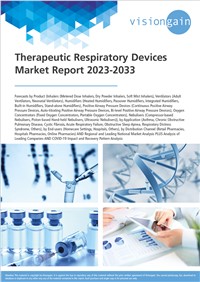The Therapeutic Respiratory Devices Market Report 2023-2033: This report will prove invaluable to leading firms striving for new revenue pockets if they wish to better understand the industry and its underlying dynamics. It will be useful for companies that would like to expand into different industries or to expand their existing operations in a new region.
Rising Prevalence of Respiratory Diseases Driving Market Growth
The number of respiratory disorders is growing globally due to a variety of causes such as pollution, lifestyle choices, and smoking. According to WHO, an estimated 65 million individuals have moderate to severe chronic obstructive pulmonary disease (COPD), with around 3 million dying each year, making it the world’s third greatest cause of death and the number is growing. About 334 million people worldwide are suffering from asthma, childhood’s most frequent chronic condition, impacting 14% of children. The frequency of asthma in children is rising.
The primary factors driving the growth of the therapeutic respiratory devices market are an increase in the frequency and incidence of respiratory disorders, technical innovation, and increasing government and non-governmental organisation support for respiratory disease healthcare awareness. Increasing awareness of respiratory disorders among the general population and governments is predicted to improve the market for respiratory medicine delivery products.
Limited Reimbursements Likely to Hamper Market Growth
Patients’ reimbursements are frequently used to pay for medical services. There is now a reimbursement gap in the diagnostic sector as a whole, and in respiratory therapy diagnostics in particular. The reimbursement schemes for PAP equipment and oral appliances differ across Europe and are only applicable in a few countries (devices not covered by insurance represent a small share of the market in the region). Moreover, respiratory care equipment is not fully covered by insurance in the majority of Asian and RoW nations. Over the projected period, high cost of therapeutic respiratory devices is likely to further constrain the market.
What Questions Should You Ask before Buying a Market Research Report?
- How is the therapeutic respiratory devices market evolving?
- What is driving and restraining the therapeutic respiratory devices market?
- How will each therapeutic respiratory devices submarket segment grow over the forecast period and how much revenue will these submarkets account for in 2033?
- How will the market shares for each therapeutic respiratory devices submarket develop from 2023 to 2033?
- What will be the main driver for the overall market from 2023 to 2033?
- Will leading therapeutic respiratory devices markets broadly follow the macroeconomic dynamics, or will individual national markets outperform others?
- How will the market shares of the national markets change by 2033 and which geographical region will lead the market in 2033?
- Who are the leading players and what are their prospects over the forecast period?
- What are the therapeutic respiratory devices projects for these leading companies?
- How will the industry evolve during the period between 2023 and 2033? What are the implications of therapeutic respiratory devices projects taking place now and over the next 10 years?
- Is there a greater need for product commercialisation to further scale the therapeutic respiratory devices market?
- Where is the therapeutic respiratory devices market heading and how can you ensure you are at the forefront of the market?
- What are the best investment options for new product and service lines?
- What are the key prospects for moving companies into a new growth path and C-suite?
You need to discover how this will impact the therapeutic respiratory devices market today, and over the next 10 years:
- Our 450-page report provides 183 tables and 300 charts/graphs exclusively to you.
- The report highlights key lucrative areas in the industry so you can target them – NOW.
- It contains in-depth analysis of global, regional and national sales and growth.
- It highlights for you the key successful trends, changes and revenue projections made by your competitors.
This report tells you TODAY how the therapeutic respiratory devices market will develop in the next 10 years, and in line with the variations in COVID-19 economic recession and bounce. This market is more critical now than at any point over the last 10 years.
Forecasts to 2033 and other analyses reveal commercial prospects
- In addition to revenue forecasting to 2033, our new study provides you with recent results, growth rates, and market shares.
- You will find original analyses, with business outlooks and developments.
- Discover qualitative analyses (including market dynamics, drivers, opportunities, restraints and challenges), cost structure, impact of rising therapeutic respiratory devices prices and recent developments.
This report includes data analysis and invaluable insight into how COVID-19 will affect the industry and your company. Four COVID-19 recovery patterns and their impact, namely, “V”, “L”, “W” and “U” are discussed in this report.
Segments Covered in the Report
Product
- Inhalers
- Metered Dose Inhalers
- Dry Powder Inhalers
- Soft Mist Inhalers
- Ventilators
- Adult Ventilators
- Neonatal Ventilators
- Humidifiers
- Heated Humidifiers
- Passover Humidifiers
- Integrated Humidifiers
- Built-in Humidifiers
- Stand-alone Humidifiers
- Positive Airway Pressure Devices
- Continuous Positive Airway Pressure Devices
- Auto-titrating Positive Airway Pressure Devices
- Bi-level Positive Airway Pressure Devices
- Oxygen concentrators
- Fixed Oxygen Concentrators
- Portable Oxygen Concentrators
- Nebulizers
- Compressor-based Nebulizers
- Piston-based Hand-held Nebulizers
- Ultrasonic Nebulizers
Application
- Asthma
- Chronic Obstructive Pulmonary Disease
- Cystic Fibrosis
- Acute Respiratory Failure
- Obstructive Sleep Apnea
- Respiratory Distress Syndrome
- Others
End-users
- Homecare Settings
- Hospitals
- Others
Distribution Channel
- Retail Pharmacies
- Hospitals Pharmacies
- Online Pharmacies



